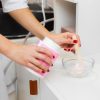- Empty cart.
- Continue Shopping
Acid Stains on Tiles? Here’s How to Remove Them Safely

Tiles provide a fashionable and resilient choice for installing flooring in residential homes as well as commercial businesses. Tiles provide protection against wear and heat along with water resistance in addition to easy maintenance. Acid stains represent one of the most troublesome and ugly problems tile owners must deal with. Acid stains create lasting damage on your tiles which also affects their appearance unless you tackle the stains right away with proper care solutions. In this in-depth guide, we explore what acid stains are, how they affect different types of tiles, and most importantly, how to remove them safely and effectively. Our focus keyword throughout this blog is tiles cleaner acid.
What Are Acid Stains and How Do They Occur?
The interaction between acidic substances and tile surfaces produces Acid stains which appear as discolored marks on the tiles. Acidic products including toilet bowl cleaners and vinegar and lemon juice and industrial cleaning agents create corrosion when they touch tile surfaces which results in dull spots and etching and discoloration.
The intensity of acid stains stems from what type of tile you have. Marble and limestone together with travertine tiles show intense reaction to acids due to their calcium carbonate content. Ceramic and porcelain tiles demonstrate stronger resistance to damage from acids but the strong acids or prolonged exposure to such substances may still cause visible damage.
Acid stains on tiles pose both cosmetic concerns and they show underlying damage that weakens tile materials over time. Quick reaction to early acid staining indications enables appropriate remedy application.
Recognizing Acid Stains on Tiles
Before treating the stains, it is crucial to correctly identify them. Acid stains can appear in a variety of forms:
- Cloudy or hazy patches: These marks frequently appear on tiles that lose their shiny finish.
- Etched or rough areas: Running your hand over the marked area can reveal different surface textures in the affected area.
- Discoloration: The color of the tile may appear faded or bleached in certain areas.
- Pitted surfaces: In extreme cases, the acid can erode tiny bits of the tile, leaving a visibly pitted or uneven surface.
Timely detection of early signs allows you to respond effectively thereby decreasing the harm to the tiles.
Safety Precautions Before Cleaning
Acid stain situations demand that safety measures become your number one priority. The mixture of acids along with cleaning agents requires careful management because their individual components present danger to handlers. Here are some safety measures to keep in mind:
- Wear protective gloves and eyewear: Keep all cleaning agents away from direct contact.
- Ensure proper ventilation: Keep windows and doors open and utilize exhaust fans to stop fume buildup.
- Keep pets and children away: The ingestion or inhalation of cleaning solutions may result in toxicity.
- Read product labels: You need to know the exact chemical components and precise guidance regarding the cleaner’s usage.
Using either homemade mixtures or commercial tiles cleaner acids requires proper safety measures to achieve effective tile cleaning.
Method 1: Using Baking Soda and Water Paste
The cleaning method operates well on gentle acid stains while working effectively with tiles of all materials including natural stone tiles.
Steps:
- Mix baking soda with a small amount of water to create a thick paste.
- Apply the paste directly onto the stained area.
- Allow it to sit for at least 10-15 minutes.
- Gently scrub the area with a soft-bristled brush or a sponge.
- Rinse the area thoroughly with clean water.
- Dry the surface with a clean microfiber cloth.
Why it works: Baking soda functions as a gentle base that balances acidic substances on surfaces. The substance functions as both a delicate abrasive that moves stains but leaves tile surfaces unharmed.
Method 2: Using a Commercial Tiles Cleaner Acid
Stronger or older acid stains could require using a specialized solution for proper cleaning. A specially formulated tiles cleaner acid serves as the efficient solution for this situation.
Steps:
- Choose a tiles cleaner acid that is compatible with your tile type. Check for pH-balanced formulas if you are dealing with natural stone.
- Wear safety gear including gloves and goggles.
- Apply the cleaner to a small, inconspicuous test area first.
- If safe, proceed to apply the product to the stained area using a sponge or cloth.
- Allow it to sit for the recommended time.
- Scrub gently with a brush.
- Rinse thoroughly with water and dry the area.
Note: Apply this method only in small quantities while strictly adhering to product guidelines. The “acid” part of tile cleaning solutions does not necessarily mean the product will be damaging to tile surfaces since manufacturers make non-aggressive tile-safe cleaners.
Method 3: Using Oxalic Acid
When you need to remove strong marks from granite or other hard stone tiles oxalic acid proves to be an effective solution. You should apply this cleaning solution to tiles if they tolerate acid-based cleaning solutions.
Steps:
- Dilute the oxalic acid according to the manufacturer’s directions.
- Apply it to the stained area using a cloth.
- Let it sit for 2-3 minutes.
- Gently scrub with a soft brush.
- Rinse thoroughly with clean water.
- Dry the tile completely.
Oxalic acid removes rust and organics effectively from tiles but users should proceed with care because of its potential strength level.
Method 4: Polishing Etched or Dull Tiles
Rubbing down tiles will not improve their appearance once acid etching occurs and produces a dull or rough finish. Tile restoration through polishing becomes necessary when cleaning alone does not resolve the issue.
Polishing Process:
- Clean the tile thoroughly.
- Use a polishing compound designed for your specific tile type.
- Apply the compound using a buffing pad or electric polisher.
- Polish in circular motions until the surface regains its shine.
- Clean and dry the area after polishing.
The technique applies to tiles by creating a renewed surface which preserves their original appearance.
Method 5: Professional Restoration Services
Home repair approaches often prove inadequate when acid stains reach deeper layers or when tiles hold significant value. A professional tile restoration service provides optimal results when deep acid stains affect tiles significantly.
What Professionals Offer:
- Deep cleaning and stain removal using industrial-grade equipment
- Tile honing and polishing
- Surface sealing to prevent future damage
- Expert assessment to avoid further deterioration
You will avoid costly and labor-intensive tile replacement through the use of professional intervention.
Preventing Acid Stains in the Future
Preventing problems is more cost-effective than fixing them after they occur. After cleaning tiles you must establish prevention techniques which stop acid staining from recurring.
- Seal Your Tiles Regular sealing of natural stone tiles forms a protective shield against acidic substances which should be done periodically. Reapplication of the sealer needs to take place every one to two years according to the location of tile installation.
- Use pH-Neutral Cleaners Avoid acidic or bleach-based cleaners. Choose pH-neutral cleaning solutions that are designed for tiles.
- Clean Spills Immediately Clean all spills of juices and sauces and cleaning solutions from tiles immediately. Over time these substances gradually construct increasing harm to the tiles.
- Educate Household Members All household members should understand which cleaning products are appropriate for tiles and which alternatives are forbidden.
- Label Cleaners Clearly Keep acid-based cleaning materials separate from tiles by placing each in labeled storage along with proper distance between them.
Choosing the Right Products
The market is filled with various products, but not all are suitable for every tile type. When shopping for a tiles cleaner acid, consider the following:
- Is the product pH-balanced?
- Is it safe for your specific tile material?
- Are the instructions clear and detailed?
- Does it include safety information?
- Are there positive customer reviews?
Brands with sound reputations make available environmentally safe products which efficiently cleanse and protect surfaces.
Conclusion
Tile acid stains are regular occurrences that people should learn to prevent through caution. Measurable action followed by appropriate treatments will protect tiles against lasting harm when accidents happen in kitchens or bathrooms. To treat different severity levels of tile stains you can pick from homemade remedies and specialized tiles cleaner acid products that range from baking soda paste to professional cleaners.
Strive to maintain both safety standards and precision during your work process. Before application always perform a test on a small area of tiles while using protective equipment and then seal the area properly to ensure your tiles remain fresh for extended periods.
When in doubt, don’t hesitate to call in a professional. After all, preserving the beauty and longevity of your tiles is worth the effort.





